Solaris review. A life’s work: Three views on the John Bowen Solaris …
First: “The Solaris is a fusion of the most important synthesizer designs of the past 40 years”
It may sound presumptuous: the John Bowen Solaris is in some ways the epitome of synthesizer design since the 70s. Let’s see … there are various oscillators to choose from: Minimoog, CEM, Microwave, Prophet-VS, Wav (samples). Or consider the filters: Moog, Oberheim, SSM, multimode filter, comb filter, vocal filter … The modules are a journey through synthesizer history. Sure, it’s all purely digital, but the sound quality is excellent. Impressive.
Second: “The Solaris is the life work of a synthesizer enthusiast and musician”
The Solaris’ enormous musical potential is no accident. As the first ‘official’ demonstrator for Moog, as co-founder of the Prophet-5, as part of the team that developed vector synthesis (the actual concept for VS came from Chris Meyer) and due to his decades of experience in playing instruments and programming factory sounds – Bowen has been able to contribute his vast knowledge to the development of the Solaris. Above all, Bowen is a real musician. All this is reflected in many details and in the user-friendly Solaris concept.
Third: “The king is dead, long live the king!”
Many years ago I realized that the polyphonic analog synthesizers of the late 70s and early 80s had ushered in their own demise. Polymoog, OB-X, ARP Quadra, Prophet-5, Rhodes Chroma, Memorymoog, Yamaha CS-80 and PPG Wave 2.2 … many of those instruments never left the prototype status, strictly speaking (you’ll pardon my slight exaggeration). Only a few instruments were actually “very” reliable, such as the Roland Jupiter-8 or Oberheim OB-8. Well-to-do musicians often had several units of the same instrument with them on tour, a prophylactic measure against the all-too-common technical failures. Vintage polyphonic synthesizers were (and are!) simply unreliable … and they’ve always been very expensive.
Today, skilled technicians have been able to bring some of those instruments up to the technical standards that would have been very desirable 30 years ago. Sophisticated services and major modifications on the Rhodes Chroma or Memorymoog, e.g., have refined these instruments to a high degree (although this, by very modern standards, is unfortunately still “limited”).
Anyway, no wonder the appearance of digital in the mid 80s was so overwhelming. In addition to an increase in polyphonic options, the digital instruments were significantly cheaper, more compact and more reliable as well.
But that’s not the end of the story. Digital synthesizers had (and still have) other limitations. Many of them are in some way inoperable, their dynamic ranges unspectacular, a lack of musical quality in their sounds, etc. Programming Yamaha’s FM was (and is) not everyone’s cup of tea, ditto for Casio’s phase distortion (a mysterious handling of envelope parameters). And working with sampled sounds has led to a lot of thoughtless playback-music. What we needed was intelligent sound programming! The typical manufacturers’ strategy (we’re talking about Roland, Yamaha, …) was to try to compensate for the lack of programming options by offering an even larger contingent of sounds (thousands of sounds, which is a horror when one thinks about it).
Many digital synthesizers are miles away from being musician’s instruments, a situation little changed today (with exceptions few and far between). Keep in mind, we’re talking about “polyphonic” synthesizers! Although the industry has tried to make the use of the instruments more palatable in recent years with the addition of a few buttons and sliders, the creative potential of the “user-friendly” instruments has not significantly increased. Ultimately, most digital polyphonic synthesizers are nothing but sophisticated sample players. A Renault R4 with a Porsche emblem on the hood, if you will.
John Bowen’s Solaris closes this gap. Although purely digital, it’s a programmers’ instrument, a music synthesizer for musicians. Solaris offers direct access to the entire sound structure, it invites you to create your own sounds “starting from scratch”, that is, with the oscillators …. The Solaris offers no piano, guitar or saxophone samples (you can load appropriate samples if you absolutely have to)! The instrument has enormous creative potential, fantastic performance features and thus provides a real synthesizer in the most beautiful and best sense of the word. Above all, the emitted sound quality is excellent.
Correctly speaking, Alesis Andromeda, Jomox SunSyn and a very few other instruments have closed part of the gap between vintage and modern polyphonic synthesizers during the last 15 years. But the Solaris’ extremely comprehensive sound architecture (wavetables, etc.) is clearly a giant step ahead …
Good things come to those who wait …
Rarely have I longed for the development of an instrument as much as for that of the Solaris. Well, good things come to those who wait. In this case, it was a long wait: From the first announcement to the final model, it has now been several years. John Bowen had some bitter setbacks to deal with, followed by forced breaks when he had to refinance the instrument. But Bowen’s persistence has paid off: The sophisticated and versatile Solaris will be a momentous success.
A couple of impressions …
The first contact with my Solaris brought some surprises. The instrument was easily unpacked – solid cardboard, foil to protect the instrument – as should be. It initially felt good, stable and robust. But there was this additional little packet in the box with – hold on here – an external power supply! At least it was a very efficient and power-saving power supply, or so it said in the directions. True, the big advantage of external power supplies is that there is no significant heat development inside the instrument, a fact I always find reassuring. And, should the transformer be faulty, this could be replaced without sending the whole Solaris off for repairs. But the fact remains, that external power supplies are not a very elegant solution!
“Yes, the power supply is outside of the synth. This avoids noise in the audio, and makes things simpler in the production.” (John Bowen in his Solaris User Guide p. 9)
Well, that’s true.
Let’s stay with the hardware and some of the finer things in life. The Solaris keyboard is – how else could it be – excellent. The feel is good. Also excellent the joystick, the display, the buttons and knobs. Or maybe “satifactory” is more accurate here, for two reasons. First, we all know that the hardware of the noble 70s and early 80s cannot be matched today. Second, Solaris production (currently in Germany) has not yet banned minor weaknesses. Pitch wheels without properly closing zero points and other such irritations are an indication that the production still has potential for improvement. As John Bowen and his team are on their toes, such shortcomings should be remedied soon.
Let’s continue with the hardware. There’s a huge choice of rear panel connections: 8 individual outputs, four independent inputs (although only monophonic) and USB, S/PDIF, MIDI plus two pedal inputs and a Compact Flash card slot.
Due to what John Bowen calls “old school” layout and control (the Oberheim Matrix-12 and Xpander probably served as models), quick and precise programming is innate to the instrument. As with the Oberheims, the Solaris programming is divided into “Pages”. The MAIN page is all about oscillators, waveforms, pitch (> oscillator section) and filters, filter types, frequencies and resonance settings (> filter section), etc. Pressing the MODulation button brings up the associated MOD page. This principle is the same throughout the signal path (OSCs, LFOs, Filters, VCAs, ENVs …) – everything very precise and extremely user friendly …!
Polyphony?
Concerning the instrument’s polyphonic potential, a precise assessment is difficult. We have no exact information on how many voices the Solaris has. But speaking from practical experience, there are hardly too few voices. Notes may be capped when playing fat clusters if release time is set to a maximum of 20 seconds. Obviously, polyphony depends on processor performance (… the power plant inside the Solaris consists of six state of the art third-generation SHARC DSP processors).
“Even with a complex program utilizing all four oscillators, four filters, four mixers and healthy doses of modulation, you can still expect 10 note polyphony!” (www.johnbowen.com)
You will probably have little reason to fully realise the Solaris potential at hand. A two- or three-part sound will generally fulfill all of your needs. As a rule of thumb and in my opinion, the Solaris will place 10 to 20 voices at your disposal. When I asked him, John was more cautious: “… for now it is fixed at 10 voice polyphony.” (John Bowen)
Sound and Performance
Now things get interesting. The bottom line is musical quality, the most central question about an instrument. Sound and performance stand in direct relation to each other and should be dealt with together. A good sound requires immediate access and user-friendly tools.
With Solaris you have four parallel synthesizers (“parts”) in one package, which means many oscillators, many waveforms, a myriad of mixers and filters, countless envelopes and first-class modulation possibilities. Enough to keep you investigating new sounds for at least the next 20 to 30 years. Now to the crux of the matter: the Solaris sound quality results from, among other things, a surprisingly wide dynamic range potential. Herein lies the central weakness of most digital synthesizers – they may sound brilliant, but at the cost of reduced dynamic flexibility. They always sound a little “flat”. The dynamic flexibility of a single analog voice, from say a Minimoog or a Pro-One, is capable of bringing any digital sound to its knees.
A musician friend recently reported from Munich that a brand new Roland Fantom keyboard used at a rock concert had no chance in the mix, whereas the little antique Moog Satellite squatting next to it came through clearly.
Originally, I had exactly these concerns regarding the Solaris. Digital is digital, there’s no way around that – and a VCA is the only thing that allows for wide dynamic range. However, the Solaris dynamic potential is impressive. Probably as good as can be had on a digital basis. Incidentally, don’t let the label “VCA” confuse you. It’s just not true. John has confirmed my suspicions:
“Sorry, the Solaris is all digital. Originally I had the word amp instead of VCA, which I guess we should have left there, but I kept calling them VCAs, so we changed it. Think “Virtually Controlled Amplifier” ;-) (John Bowen)
In the Solaris, extensive sound material meets high sound potential, and the two encounter remarkable performance potential: A weighted (grippy) keyboard, assignable wheels, a joystick, a multiple zone ribbon controller, etc … These are the decisive ingredients for good sound performance. In addition, there is that small but defintely notable step sequencer…. Not one of those tools with thousands of possibilities (as in many so-called “workstations”), but extremely easy to operate and to the point: 4 tracks of 16 steps, upon request with different track lengths, each track assignable … to the SSM filter, to LFO 4 speed, to the oscillator wavetable No. 29 – and one track for the melody itself … what more could you want? In addition to the sequencer there is also a flexible arpeggiator on board. With the Solaris, creativity knows no limits.
Now one highlight must be mentioned that could easily be overlooked …
Octave Up/Down
Well, a keyboard up / down switch wouldn’t seem to be that spectacular. But keep in mind: Solaris is synonymous for unlimited sound potential. Four parallel synthesizers in one package, classic waveforms, a wealth of wavetables, rotors, numerous filters, 6 LFOs, 6 envelopes … and all that within the limits of a 5 octave keyboard! But is that really and truely enough? Not without good reason did Waldorf produce its legendary Wave in a 76-key version to warrant additional soundspace.
Here is where the Solaris octave switches come into their own! What makes them so unique is not the fact that they enable keyboard transposition up or down 1 or 2 octaves. The speciality lies in the fact that the current sound can be retained (press the sustain pedal or the hold button), while at the same time the surrounding octaves are transposed up or down. This embeds your sound in a choice of 9 octaves! Soup isn’t just about ingedients, it’s also about savour and spice …
Interestingly enough, the great John Bowen himself doesn’t seem to be fully aware of the usefulness of the octave buttons.
“These buttons should be self explanatory. They change the range of the keyboard, but must be pressed before you play to get the transposed values. They will not transpose keys currently held.” (Solaris User Guide, page 15)
In my opinion, the uniqueness of these buttons lies in what happens if you don’t press before playing. Play first, press “Hold” (or the sustain pedal), then shift the keyboard range up (or down) and add more notes. The sonic results are marvellous.
The tone-chameleon
Lists are not very attractive, but they put things into orderly perspective. The following is a detailed list (with some explanations …) of components of the Solaris sound architecture:
4 Oscillators
For each oscillator, there is a choice between:
- MultiMode Oscillator (sine, triangle, ascending sawtooth, descending sawtooth, pulse, noise, sample & hold, morphing sawtooth, morphing pulse, “jaws” – 7 stacked sawtooth waves)
- Wavetable Oscillator (the 63 sets of Waldorf Microwave wavetables)
- CEM – Curtis Electromusic Oscillator (sawtooth, triangle, pulse, saw + triangle, triangle + pulse, saw + triangle + pulse)
- Wav – Sample Playback Oscillator (Solaris loads samples from the CompactFlash card into the RAM. There’s a total of 32MB of sample RAM)
- Vector Synthesis Oscillator (94 waveform sets in the style of the Prophet VS)
- Mini Oscillator – Minimoog Emulation (triangle, sawtooth + triangle, sawtooth, pulse 1, pulse 2, pulse 3)
All the “usual” parameters such as tuning, fine tuning, sync, shape (determining the shape of the waveform across its continuum), phase, glide and linear FM are available. In addition, you have LOW (frequency) mode, which turns oscillators into LFOs. Switching keyboard tracking off (NO TRACK-button) will give you a “fixed” pitch. CLOCK SYNC allows you to synchronize the frequency of the oscillators to divisions of the MIDI clock signal.
2 Rotors
Rotor is a term generally associated with helicopters. As there, so here: something turns. The Solaris rotors represent sound sources additional to the oscillators. To put it simply, a rotor generates a 4-step waveform sequence in circular rotation. The sources of the rotor sounds are completely user definable. Oscillators, LFOs, filters, mixers, external audio inputs, envelopes, the sequencer rows A to D and so on: the choice is yours.
Actually, a rotor is far more than a 4-pole audio source: it may be used for control signals as well …
“Think of the Rotor as a 4-input mixer, that turns up one channel at a time. If sub-audio signals are fed into it, you won’t hear anything as a contributing component to the rotor sound for those positions.
On the Solaris plug-in, I have a rotor that is disguised – it’s called a Modulation Mixer. I used it to slowly blend LFOs. So, you could have, for example, all 4 Rotor inputs being the LFOs 1-4, and each at a different rate and shape, then use the output to modulate things – and setting the Rotor to a very slow rate, you can have subtle variations of modulation going on, but that would still be cyclical over the long run.” (John Bowen)
Back to the rotor being used for audio purposes. When the rotor is in the NO TRACK mode, it behaves like a slow-playing wave sequence. Frequency control is possible (as with any LFO). If, on the other hand, NO TRACK is disabled, the rotor functions as an oscillator – with a very unusual waveform, of course …
The entire sound material — oscillators, rotors and much more — is now fed into the …
4 Mixers
Each mixer has four inputs. The oscillators, the two rotors, the four insert effects, even the mixers themselves, the VCAs, the filters – well, actually anything that emits a sound – can be merged with anything else. And there’s noise as an extra sound source, if you don’t want to sacrifice any of the oscillators for it. The volume of each sound source is adjustable individually. I emphasize: 4 mixers, each with 4 audio sources. That makes a total of 16 sound sources at your disposal, the level of which can be individually determined or modulated.
So, obviously the Solaris is an “open system” … the exploration of which would easily carry you far into the time of retirement (should that impress you) and beyond. We’re thinking in terms of perfect health for the next 100 years …
4 Filters
Solaris has four filters routable in parallel or series. Each of these filters can be set to one of the following filter types:
- MultiMode Filter: 23 (!) filter variations … LP4, LP3, LP2, LP1, HP4, HP3, HP2, HP1, BP4, BP2, BP2+LP1, BP2+LP2, BP2+HP1, BP2+HP2, BR4, BR2, BR2+LP1, BR2+LP2, BR2+HP1, BR2+HP2, AP3, AP3+LP1, AP3+HP1
- SSM Filter: A filter emulation of those SSM chips used in the Rev.1 and Rev.2 Prophets
- MINI Filter: emulation of the famous Minimoog 24dB lowpass filter
- OBIE Filter: Oberheim emulation, inspired by the SEM filter, it’s a 2-pole 12dB filter with LowPass, HighPass, BandPass and BandReject (Notch)
- COMB Filter: This adds a delayed copy of a signal to itself, in either a feed-forward or feed-back loop. It creates distortions, resulting in a frequency response that looks much like a comb.
- VOCAL Filter: A formant filter, which definitely sounds very excellent. A great asset, especially in combination with the joystick. The five vowels can be morphed (moved (o;) in realtime …
4 “VCAs” (in reality: 5 stereo amplifiers)
As explained above, “VCA” is not correct, but we’ll stick to the label as Bowen did. We know they are in fact digital amplifiers.
“There are actually five stereo amplifiers – the 5th one is at the end of the sound chain, just before the effects section.” (John Bowen).
Each of the 4 main VCAs accepts an input signal from either its corresponding filter or Insert FX module. The following VCA parameters can be tweaked: Input (filter, insert FX), Type (linear, logarithmic, sigma curve), Boost (soft distortion), Level (volume) and InitPan (panorama position). There are also two modulation inputs. Source 1 modulates the amplifier’s level, Source 2 modulates the pan position. Many of the attached Solaris demos make extensive use of the VCA’s panorama modulation.
5 LFOs
Solaris has 4 main LFOs and a special vibrato LFO. Each LFO supports the common waveforms (sine, triangle, ramp, etc.) plus sample & hold, of course. Frequency is adjustable between 0.000 Hz and 500.000 Hz (audio range). There’s also a parameter page with Delay, Fade In and Fade Out for smooth (“natural”) modulation. The LFOs can be synched to MIDI Clock. Ah, yes … and the LFO speed may be modulated by any of the dozens of modulation sources. By the envelopes, e.g., to get those great Yamaha CS-80 sound effects. Two of the attached sound examples refer to this … they demonstrate LFO speed modulation by EG 6 … Listen to the samples, it’s worthwhile.
6 Envelopes (in reality: 7 envelopes)
Let’s not be petty: Envelopes you need. It’s nice that John Bowen chose “classic” ADSR envelopes. A clearly structured ADSR is, in my opionion, the most practical tool for your musical requirements (easily topping 8-stage envelopes, in that respect). As we know from Oberheims Xpander/Matrix-12, all envelope parameters are voltage controllable. Very nice. Well, the ideal Solaris would probably feature real hardware envelopes (and true VCAs). Nevertheless – these digital envelopes are absolutely OK. Envelope segment values range from 0.0 ms to 20.0 seconds. Good for snappy electronic sounds … and excellent for all types of pads, evolving string sounds, etc. In addition to the 6 ADSR envelopes there is a loopable 8-stage envelope — for those among you requiring really complex time structures …
Further features
And now a simple list of additional Solaris features, since their detailled description is clearly beyond the scope of the report:
- Arpeggiator
- 4-Track Step-Sequencer
- 4 Effect Channels
- Loopable EG
- Vector Synthesis
- Amplitude Modulation
- Key Tables
- 4 Lag Processors
- Envelope Follower
Excellent grooves, ring modulation effects, individual key tables, synchronization of effects (delay) and MIDI clock are among the additional features we’re talking about.
A little more performance …
By the way, the bottom five knobs below the graphic display can be completely freely assigned. Concerning the Assignable Performance Knobs, the essential point is that the user doesn’t have to leave preset mode to make adjustments. Just carry on on the waves of your musical inspiration, tweaking a knob now and then.
This goes for the ASSIGN buttons, too. (I first came across this fine feature while working with the Ensoniq TS-12.) The two ASSIGN buttons allow variation of the sound in progress at the press of a finger. Here choices include Keyboard Glide on/off, Oscillator Glide on/off, Seq start/stop, Arp start/stop and Arp transpose. When selected in the Mod Source list (see below), the ASSIGN buttons generate full value (MaxValue) when pressed and zero value when not.
The four ENABLE PART buttons are also worth mentioning. Since the Solaris is permanently in Multi-Mode (meaning up to four sounds make one “sound”), you can disable or mute each individual sound component “on the run”, while you’re actually playing. It’s a system of musical building blocks: pile sounds on, pull sounds off — until you’ve got the building you want.
A little hint concerning knob acceleration: Press SHIFT to speed-control movements. This can be a real help when you’re programming LFO frequencies, for example. If you want rapid changes, you can supersede the fine adjustment by simultaneously pressing SHIFT.
It’s not just about programming with Solaris. Programming and Performance go hand in hand!
Modulation Sources
Since the oscillators, mixers, insert effects, filters, LFOs and VCAs may be modulated in many parameters, the list of the modulation sources is of great importance.
- LFO 1-4
- Vibrato LFO
- Envelopes 1-6
- Looping EG’s X axis
- Looping EG’s Y axis
- Velocity
- Aftertouch
- Note (MIDI note number)
- Modulation Wheel
- AT + ModWheel (sum of the two)
- Ribbon 1
- Ribbon 2
- Joystick X axis
- Joystick Y axis
- CC1-CC5 (user defined controllers)
- Sequencer tracks A to D
- Pedals 1/2
- Assign Buttons 1/2
- Envelope Follower
- Key Tables 1-4
- Poly Aftertouch (via MIDI, unfortunately the keyboard’s AT is only monophonic)
- Lag Processors 1-4
- Breath Controller
- MaxValue
- OSC 1-4
- Rotor 1/2
- AM 1/2
- Vector 1/2
- Mixer 1-4
- Filters 1-4
- InsFX 1-4
- VCA 1-4
- White Noise
- Pink Noise
- Ext 1-4
- SPdifL / SPdifR (S/PDIF)
The envelope parameters can only be modulated by velocity, key tracking, the individually assignable modulation wheel and the controllers CC1 to CC4. But that’s more than enough …
Memory – the importance of the Compact Flash card
Please note: Unlike most other synthesizers on the market, the Solaris has no internal memory. All sound-, sample- and sequencer-data (and the OS) is saved on the supplied Compact Flash (CF) card. So the importance of this Compact Flash card is obvious. The bad news: the loss of the card would be a minor catastrophy, its consequences difficult to estimate. The good news: storing back-ups of that vital CF card on your computer is very simple. The cards are cheap, too, so the purchase of a second one and the creation of a duplicate is in no relation to the risk of complete loss. We’re talking about an investment of a few extra Euros/Dollars …
“Another thing I like to point out – you have your entire Solaris contents on the CF card, so you can take just your card to another place that also has a Solaris (studio, friend’s house) – insert your CF card, and voila! You have it just as if you had packed and brought your own Solaris keyboard with you!” (John Bowen)
Solaris and the local heavy weight JD-800
20 sounds! On the first night with my Solaris I created 20 sounds of my own. It’s always a good sign if you can quickly and easily create sounds on a synthesizer of this complexity. It clearly speaks for the musical instrument.
Straightaway, the Solaris had replaced my favourite polyphonic of 20 years (the Roland JD-800). Even tho’ the JD-800 still sounds warmer (being simply unique in this respect – why, I do not know), the Solaris opens entirely new worlds with its masses of sound material.
Working with wavetables is a real delight, something I would hardly have imagined up till now. The combination of traditional (sawtooth) string sounds with a touch of wavetable is particularly appealing. Above all, I would like to emphasize the numerous performance-oriented controls. The joystick is noteworthy. Its X and Y position are available in most modulation source lists. It allows for simultaneous real time control of multiple filter frequencies, LFO speeds, oscillator tunings etc.
Since the JD-800 has already served as a comparison, I would like to proceed with comparisons based on the Alesis Andromeda — a high quality (analog!) instrument, state of the art. In contrast to the Andromeda, however, the Solaris is a hand and a foot ahead. The instrument is completely navigable from the very first (!) minute.
The user knows exactly where he is, what he has done, what he is in the process of doing, and what his next steps must be in order to achieve the sound he is going for. These are things I have never managed to this point of perfection with the Andromeda.
The user knows exactly where he is, what he has done, what he is in the process of doing, and what his next steps must be in order to achieve the sound he is going for. These are things I have never managed to this point of perfection with the Andromeda.
Conclusion
The Solaris is a synthesizer in the best sense of the word. Minimal conceptual shortcomings (such as the external power supply and the tedious process required for saving and naming new memory locations) can be overlooked. The crucial point is the musical potential. A multitude of sound options, intuitive user interface and superb performance features make the Solaris a milestone in synthesizer history.
With Solaris, his life’s work, John Bowen has created an in-depth musical instrument.
In connection with the audio files, please note: These contain 50 (!) minutes of music. Everything is Solaris “pure” — no external effects, no additional sequencer, not even MIDI — with the necessary exception of a recording tool (freeware Audacity), which served for basic recording and sound mixing.
Elkas masterkeyboard MK88 was used in two soundfiles (“polyphonic aftertouch”) for variation of Solaris filter frequencies and LFO speeds, based on independent key pressures. (No knobs were tweaked, it’s all “finger control”).
Enjoy …!
John Bowen Solaris
Polyphonic digital synthesizer
Price: approx 3900 Euros / 4100 USD
Website Manufacturer:
www.johnbowen.com
Links:
Review by Robert Wittek
Interview with John Bowen
Audio-Workshop by Robert Wittek:
- Audio Part 1 (… short introduction in German)
- Audio Part 2
- Audio Part 3
- Audio Part 4
- Audio Part 5
- Audio Part 6



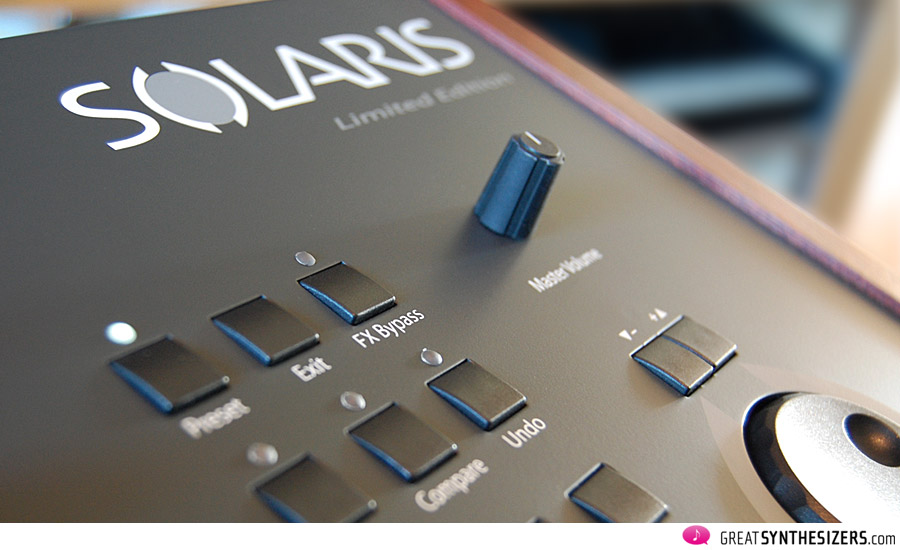

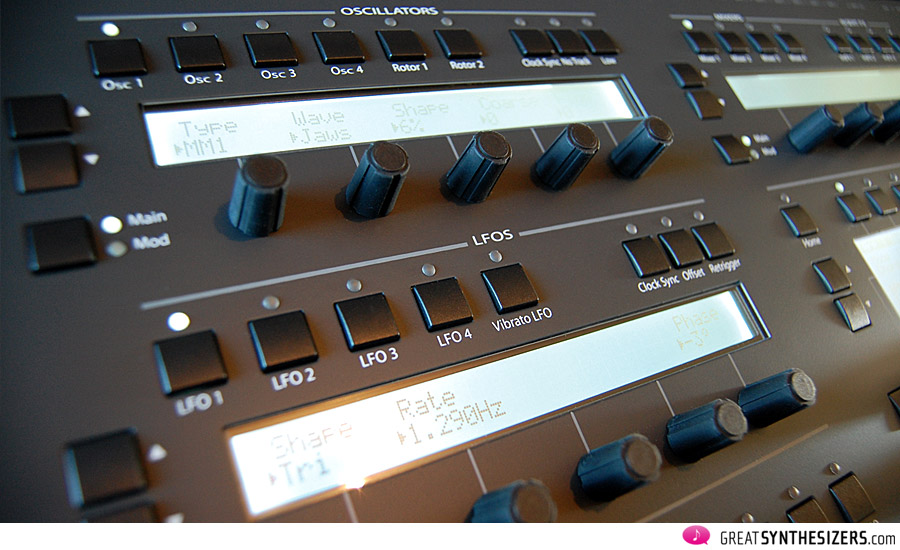



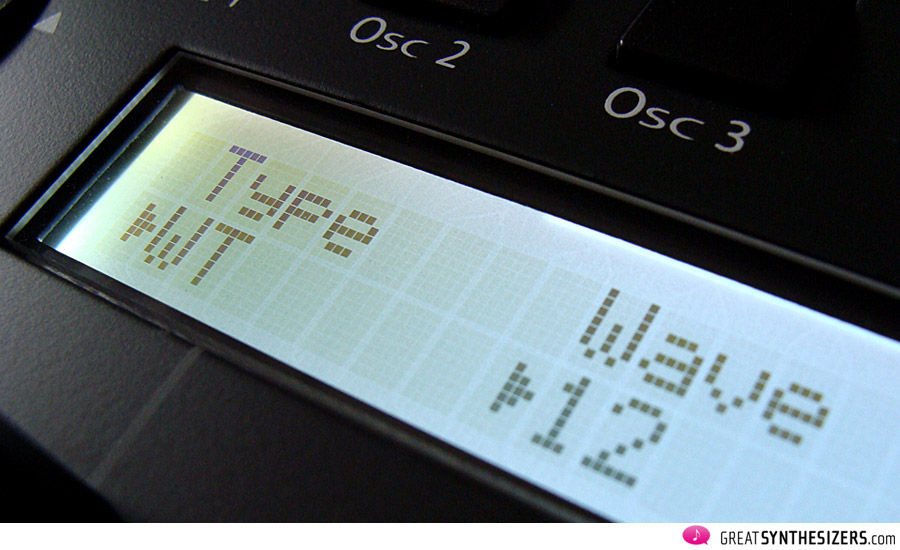
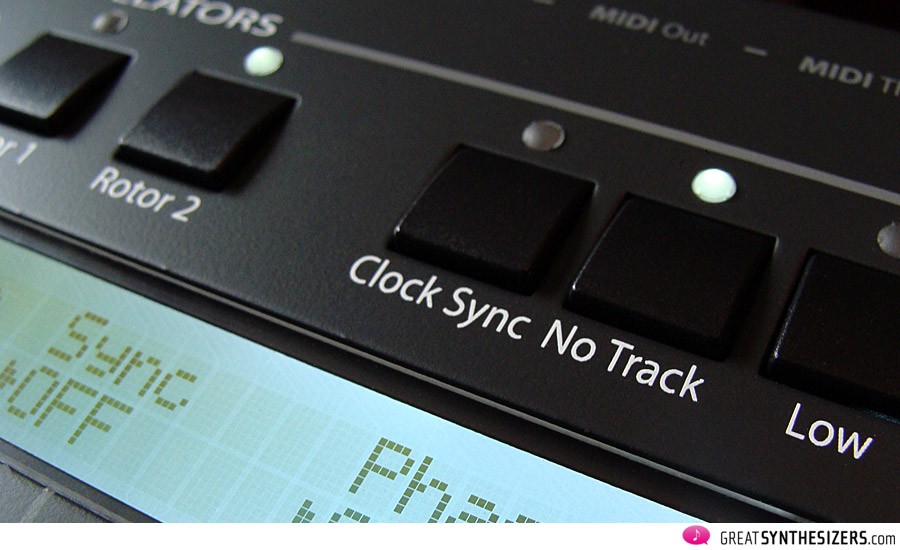

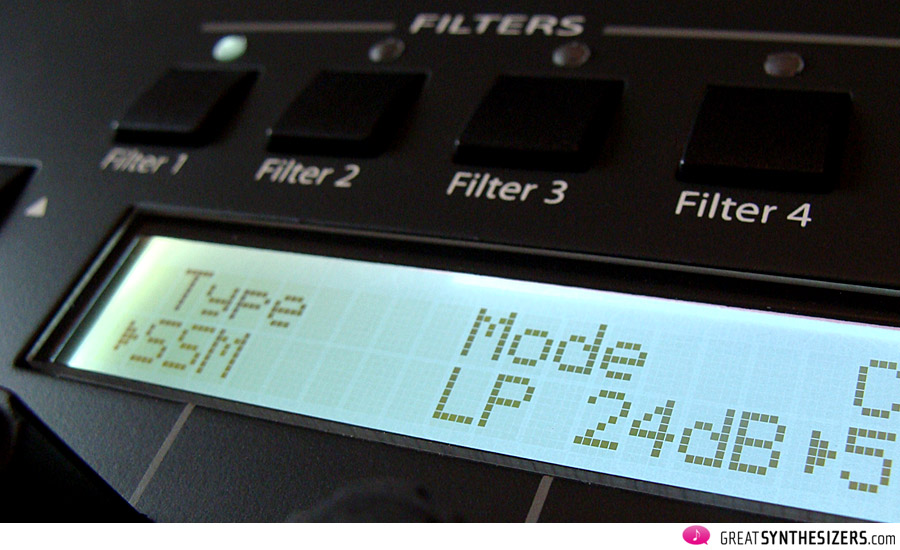

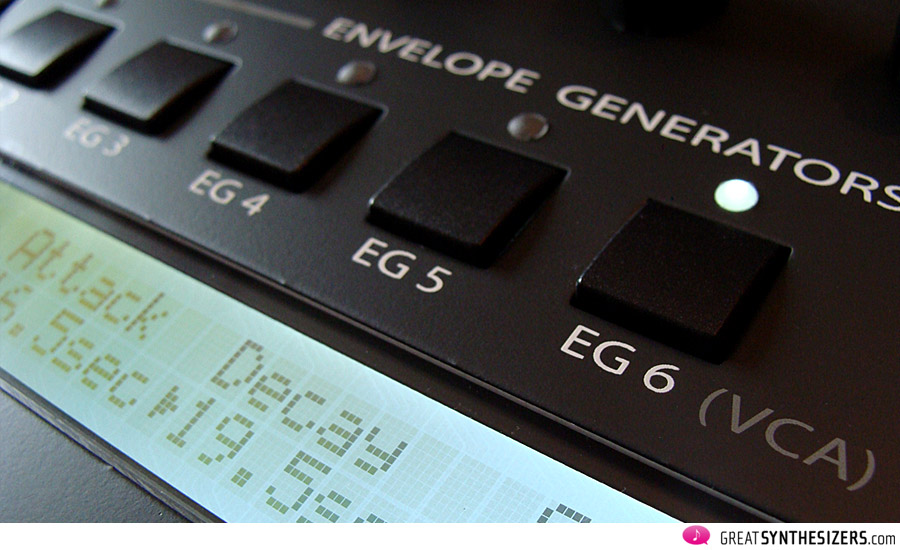


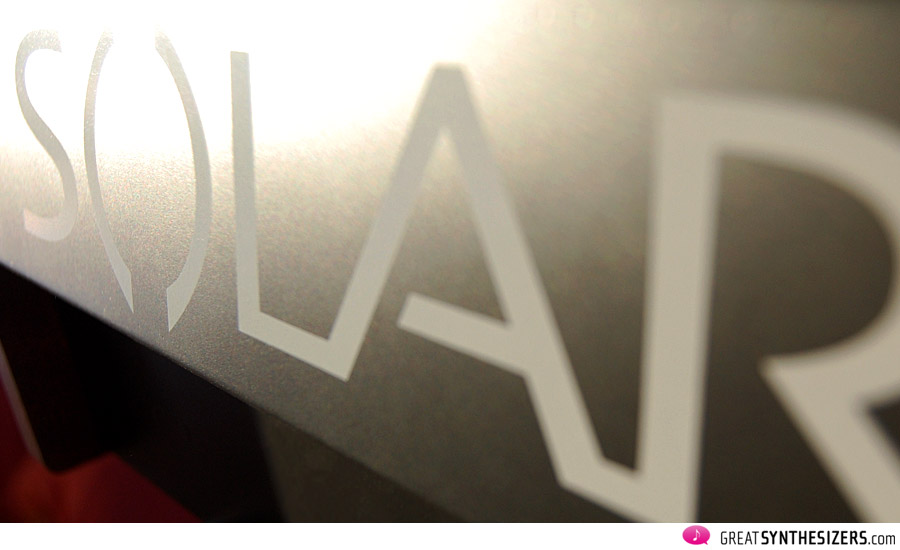

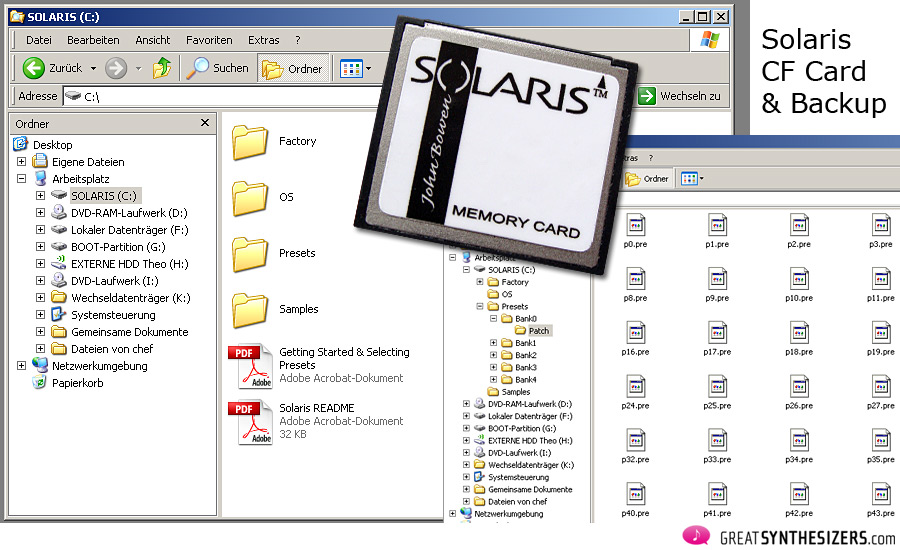


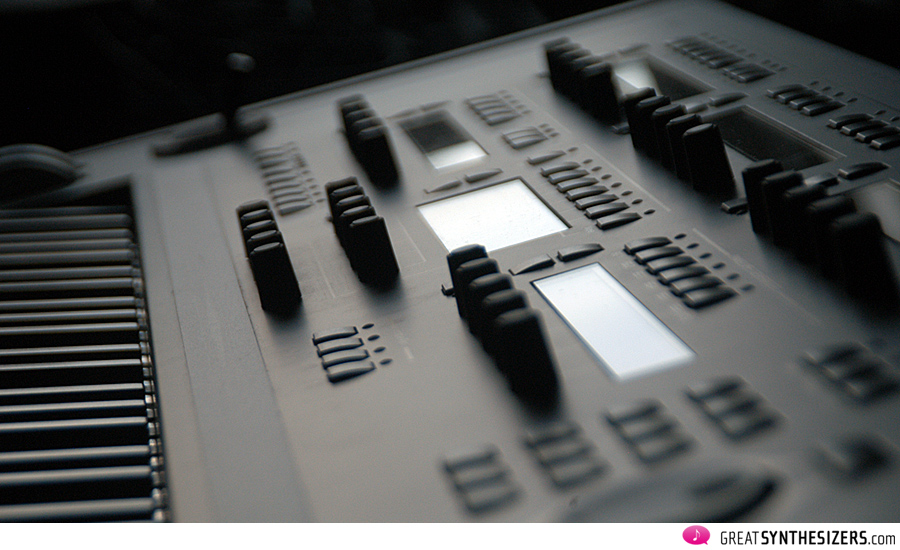
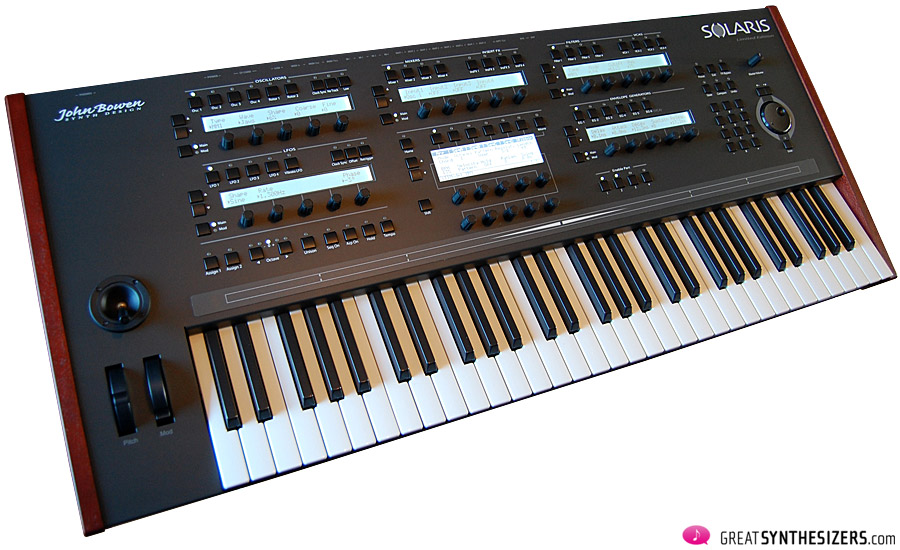
Thanks a lot, very helpful review.
Also these are the first competent demos I’ve seen thus far, very well done.
Many thanks for a great test about a great piece of gear…
Solaris is … just very perfect in many aspects. But I want fully multi-mode.
Gorgeous synth, but damn if this wasn’t one giant piece of advertising!
… well, this “is” a wonderful instrument! Happy New Year …
First of all, I would like to say that you did a complete review of Solaris Thanks a lot. I have played from Classical music ( I own a Kawai mp8 stage piano where I play all that music) to Rock (from 80´s to indie), electronic, and funk. Since I want to play in bands but I also want to continue producing music for comercials or musicals.I ordered A Rare red alesis andromeda ( almost new) but I want to complement it with another synth. My question is if the Solaris replaces or complements a lot the Andromeda in a live stage and recording studio. I would think they complement each other , but maybe I´m wrong . I ask you this because you compared both and I don´t want to stop using one of the two because the other one is much better.
I forgot to tell you that I have plans to buy a Solaris in the next few months.
Hello David!
An answer here is somewhat difficult. But I’ll try. The Alesis Andromeda is a “very” good synthesizer. It is analog, so it has fast envelopes and a very powerful sound. It is in general “not” on the subtle side, I guess. If your music tends to electronic pop or techno, then the Andromeda might be the right choice. Fat basses, punchy, hard, analog sounds … it’s difficult to “describe”, but you can imagine (and probably already know) the Andromeda.
Sound is “one” aspect. Another question is programming and user friendlyness. Usually I’m not very happy programming the Andromeda. Sure, it is full of buttons, but somehow programming is a little difficult … and not as intuitive as I hoped it would be. Often it happens that I wanna change a sound quickly, but although I’m very experienced in synthesizer programming and although I know quite exactly what the desired sound “should” be like, I never get there. Don’t know why. I call it the Andromeda phenomenon.
[By the way: It does not matter whether the Andromeda is blue or red, they are the same, aren’t they? I wouldn’t pay any extra money for the red version …].
Back to our question: Solaris versus Andromeda. If your music style is more widely, if e.g. orchestral sounds, interesting film score sounds and organic pads with lots of modulations inside play an important role, I would highly recommend the Solaris. Its sound quality is exceptionally good. Plus – and this is at least as important as the sound quality itself – programming the Solaris is a lot of joy. The work flow is intuitive and the 6 (!) displays are of great value, of course. Programming the Solaris you “never” get lost (I can’t imagine how that should happen).
The sonic specialty of the Solaris is all kinds of pad sounds (as mentioned before), further wavetable sounds, lead sounds, strong unison sounds, experimental stuff (another big plus!) – thanks to ringMod, vector synthesis, highSpeed LFOs, etc.
To sum it up, I think the Solaris is much more flexible (and user-friendly) than the Andromeda. What’s not to say that it is the right instrument for you. It depends on your musical needs. To me, however, it’s the “perfect” (ok, “near-to-perfect”) polyphonic synthesizer.
I hope you find the right decision.
Regards,
Theo
Wow!! Thanks Theo by the way I enjoyed your demos.
There is a little diference between the red ones and some blue Andromedas because the Red ones where built when the company Alesis was not sold to Numark. The was a bad badge of Andromedas in the last years and the red ones where made before with probably higher quality as said in many forums. They were only 250 made of them. To me the looks of the red are also . I know that music is what it is most important but those little things in the looks are cool. That´s why in John´s case They made the first 100 units with his signature and limited edition on the Solaris.
Thanks for your answer one again.
All the best
David
… thanks. I did not know about the difference of the two Andromeda versions. And you’re right. The red one looks “very cool”. Oh yes, the first 100 Solaris were a limited edition, I’ve noticed that too little. So I’ve got a limited Solaris. Nevertheless I’d prefer a “real” power plug over John’s signature (sorry, John). Anyway, the Solaris is pure joy of making music. I just decided to sell some of my vintage polyphonics. Their repairs cost me too much. And Solaris does almost everything I need.
Thanks for stopping by …
Theo
I hope you don´t sell your Andromeda :O You never know where the Andromeda Phenomenom will take you ;D
Wish i could afford this great sounding synth. I would promote the hell out of it.
the andromeda uses quite sluggish software envelopes.
Ah, yes. Alright …
Nice review with the sound clips.
I wish you had discussed the sound more though. You write, and I agree: “The bottom line is musical quality, the most central question about an instrument.” But you leave the reader hanging and conclude nothing with regards to sound, that’s a bit strange! I can’t help thinking it’s because the old analog is still more musical :)
You are right, but answering this question would require a very long discussion, considering the different aspects that are involved. But let’s stick with “sound”. The Solaris is very good. Maybe it’s the best of virtual (analog) synthesizers. At least that’s my opinion. Of course, a pure analog synthesizer still sounds better. There’s no doubt about it: a bass just doesn’t sound like a Memorymoog (or a Minimoog). And a cutting brass just doesn’t sound like a Yamaha CS-80. However, both machines are unreliable. Hence the question: What good are tools if they do not work properly? (My Elka Synthex is having problems again and the Prophet T8 also has a missing voice). The Solaris works.
Analog polyphony has never worked well – and will not do so in the future. So, what good are sound ideals if they can’t be realized? The Solaris is an all-in-one package: reliability, adequate polyphony, a flexible sound engine, in-depth programming options, user-friendly (and up-to-date) performance features and a very “musical” sound.
Maybe my view is a bit too enthusiastic. But I’ve spent the last 20 years trying to get to know the many problems of vintage polyphonic synthesizers. [Monophonic machines are very reliable and relatively maintenance-free. No problems with an ARP-2600, Minimoog, MS-20, Pro-One, Prodigy, Axxe, SH-09, etc – they will survive another 40 years]. Polyphony, dynamic control, MIDI and storability were the major challenges in analog synthesizer history. Today we can say that these problems were not solved. Therefore, a high-quality virtual analog synthesizer appears to be the only realistic solution.
And … yes, it “would” be very nice if there’d be a reliable, maintenance-free 16-voice Elka Synthex, Memorymoog, OB-8 or Roland Jupiter-8 (with dynamic keyboard controls and modern MIDI features), but this does not seem to be feasible.
Thank you for the review and the overal site very good content/demos !
Isham
It’s great that you like it!
I find the Arturia Origin sound as good as Solaris, and more analog. It’s also modular, with the same power (DSP processors Sharc), ribbon, joystick…
Can you make a review ?
We would like to, but need to get an Origin either from Arturia or its distributor.
Digital synthesizers are also not too reliable. My nord lead had also lots of bugs. Also I´v e heard waldorf synths with many bugs and even a test unit that was used by Ken.
with the solaris.
Hi Eric,
Fyi – we contacted Arturia and their German distributor but did not receive any reply from either of them. I am sorry but I guess we cannot review the Origin.
Peter
To bad for Arturia !
Thank you Peter.
Hi
I have a question, I know It maybe ridiculious but I am looking for a synth that has all the flexibility in the modulation like a digital synth but the organic sound of an analog synth so Do you recomend this synth solaris for this matter or should I look some place else like a radikal technologies accelerator or maybe get both to have like the perfect sonic palette.
Hello Alexander
I’d go for the Solaris. There is nothing comparable in this world. It has the flexibility of an analog modular system, sounds very (!) organic (forget most of the presets, you will program much better sounds on your own) and it is – more or less – extremely user-friendly. Looking for complex, natural, big sounds, I’d really recommend the Solaris. This is, of course, a personal opinion.
Regards, Theo
Hi Theo thanks for your reply, I love the solaris so far but I have thoughts about gigging with it. Do you think is a good synth for live use? Is it to delicate to take it on the road?, that is why I was also looking in to the accelerator which sounds great to and is really portable and seems rough. I come of playing with a Kurzweil PC361 which is very practical for live situations but still for my taste it does not have that i am looking for in a synth, So if you can give your impressions about it. Thanks.
Hello Alexander!
In this case, I would go for the Accelerator. The Solaris is more of a studio instrument. Built relatively large, it’s somewhat fragile (ok, not fragile, but in any way not suitable for the stage). If you like the Accelerator sound, then it is certainly a good buy … Regards …!
Hi Theo. You wrote that the oscilators can be set to “low” mode and serve as lfo’s. Is this possible if the chosen waveform is a wavetable or sample? or anything from all the possible waveforms? Bacause if so – it sounds very interesting indeed.
I have to check that out. Will be back in a couple of days … Cheers, Theo
Nevermind. Just saw a youtube demo where John used a sample to modulate itself. So i guess all oscilator types can be used as modulators – whether traditional waveshapes or more complex ones. It could be interesting to modulate something with a wavetable – while the wavetable itself is being scanned by an lfo. Sounds like fun.
If that’s possible then I agree! Today, a year after receiving the Solaris, I still think this is the best polyphonic sound design synth on the market. Cheers, Theo
I have tried the Solaris sounds I like very much,
but there are things that need to improve before my purchase.
1° a faster technical support, and spare parts for replacements,
2° the six display are of poor quality with what it costs at least read well all the parameters for example look at this
http://www.newhavendisplay.com/nhd0240bznswbtwp-p-448.html
or
http://www.newhavendisplay.com/nhd0420d3znswbbwv3-p-5745.html
3° connectors screwed to the chassis see power, not just soldered on the motherboard, because they are too fragile and prone to breakage,
4° the screws that hold the back of the panel, at least what I experienced, they were stripped (they were not tightened well) so they were self-tapping screws, it would have been better to put the screws to avoid threaded metallic vibrations,
I will stop for now but if I had to retry the Solaris I will report my impressions.
I tried this synth is just an hour I love it, just waiting for the best in the four points that I commented and then maybe buy it.
Theo: Do you still have the Solaris and did it replace the JD-800?
Oh, I kept both, … there are two JD-800 and two Solaris in the setup. Love them all. Both Solaris work perfectly … and the JD-800s work too (although there are some minor button / contact problems, but nothing serious). A great combination, by the way … Solaris with all the heavy modulation and wavetable stuff (plus the great panorama mod things, the joystick, rbbon and the sequencer) layered with the JD-800 (adding some extra warmth, interesting filter colors and some sort of “analog touch” to the sound) …
Hi, What do you think of the modulus 002? The Modulus, according to your opinion, it is an antagonist of Solaris? Why don’t I know decide between the two.
Hi Ric …
I haven’t played the modulus 002 yet. On the one hand It looks very promising, and people who know it already are enthusiastic. On the other hand John Bowen finally seems to have solved most production problems and continues selling the Solaris successfully. I personally like the Solaris concept very much, all those displays, all those performance tools and other goodies … it’s a complete polyphonic modular system with sequencer, etc. But let’s be honest: the modulus 002 looks awesome. Today, I would probably go for the modulus 002 first, and then for the Solaris (which just had some hardware problems right from the beginning).
Cheers,
Theo
Thanks theo, I wanted to inform you that by 20 October there will be a new video of Modulus 002 and this time very complete. This instrument is multitimbral, and with a new technology on the Vco such Nco. We can discuss the lack of two wheels but the sound is powerful, recalls the Waldorf PPG and sound that I love so much. What do you think? Riccardo
Is there a link available to download these samples?
Thank you.
I like the demos of the Solaris here. The Bright strings blew me away, version 1 straightaway. This instrument has beauty in its sound. Are these your patches, factory patches or a mixture of both?
Some of it reminds me of some Depeche Mode ‘Music For The Masses’ pieces. Maybe they used Fairlight or PPG Wave, who knows?
Speaking of the Andromeda, I ordered a red one in 2001 and then Alesis went Chapter 11 and then delivered a blue one to my music store, so I refused to take it. I still regret that, a little, but it seemed too risky and was before I heard of the takeover by Numark. So I never owned one or tried one.
Being in the UK, having a Solaris seems a little risky with no delaer or distributor, especially considering the price. However, I could imagine that it could be the only synthesizer that I needed to own if I had one.
When I hear a good sound in a demo of this synth I get lost in it, as if I am listening to a favourite album. That is unusual and indicates a very impressive and special musical instrument.
What patch are you using in the John Bowen Solaris – Polyphonic Aftertouch 1? What filter?
I also note that Katsunori Ujiie liked the Solaris a lot. He used a lot of superlatives or adjectives like awesome when he demonstrated it on YouTube.
… audio or Solaris data? Audio – no, but it should be quite easy to listen, record and save the samples on your computer.
Solaris data: yes … (presets – bank 0, nr 63 – 102)
http://greatsynthesizers.com/wp/wp-content/uploads/2015/04/Presets.zip
That polyphonic AT demo was made with one of my Solaris string sounds (preset nr. 63 or 64 …?). Download our Solaris sounds:
http://greatsynthesizers.com/wp/wp-content/uploads/2015/04/Presets.zip
The GreatSynthesizers sounds are located in bank 0. Presets nr 63 – 102 …
Hi Theo
Great review of the Solaris.
Have you had a chance to try out the new Sequential Prophet 6 yet? I recently bought one and it is an incredibly powerful and compact true analog polyphonic synth (slightly smaller than the Prophet 5 at 4 octaves).
I wonder if you have tried it, if it has caused you to revise some of your thoughts about polyphonic analog synths and their perpetual unreliability etc.
Also, I am wondering if the Solaris would compliment the Prophet 6 in a two synth set up?
The cool blue digital of the former and the warm red analog of the latter.
(John Bowen is working on this …)
… hello Haiku. Haven’t tried it yet (am a little discouraged by the 4-octave keyboard). But general feedback is very (very) positive and I think you might be right: Solaris and Prophet probably match perfectly. The wide cinemascope-like John Bowen instrument and the analog cutting Dave Smith lead synth … sounds pretty like a dream team!
Well, after giving serious thought to the matter for the last few weeks I’ve now taken the plunge and ordered a Solaris.
So many of the demo recordings I’ve heard just sound so rich, warm, organic and complex (including on this site) that this synthesizer seems like a sound designer’s dream machine.
Also, I don’t understand why so many have complained about the price considering the amount of time and energy John Bowen has invested and what the customer is receiving with this machine. I remember buying a PPG Wave 2.2 brand new back in 1984 and that cost a whopping £5k then. Not sure what that would be in today’s money but at least 3 or 4 times what the Solaris is.
The only other synthesizer out there that seems of similar complexity and versatility is the all analog Schmidt 8 voice polyphonic and that costs about £15k.
… hmmm … the Schmidt Synthesizer is beautiful, a piece of art. Don’t wanna talk it down, but I definitely had troubles programming the instrument. It’s just a little too huge. Too many signal/path- and routing-possibilities … you get lost very easily. The huge panel with all its knobs is – surprisingly – not a big help at all. Instead, you have to study the right-hand display all the time to see what’s going on. Since intuitive programming is quite an important part of the musical workflow, I’m a little disappointed with the impressive looking (and beautifully made) Schmidt. But of course this is a very personal opinion – nothing else :o)
That’s interesting what you say about the Schmidt. I was wondering whether having everything ‘out on display’ on that huge interface would make things easier or harder. So you find the Solaris easier to navigate and create sounds on than the Schmidt?
Actually, most of the demo sounds / videos I’d heard of the Schmidt had sounded quite underwhelming (the usual analog synth brass and strings palette) until I came across this video. I really love some of the sounds he’s conjuring from his machine ….
https://www.youtube.com/watch?v=X0AIVPrGEBI
Obviously the price is ‘extremely’ high so as I was looking for a more affordable analog polyphonic I came across this video of the Prophet 6. It instantly helped me make up my mind to buy one as this owner also conjures up some wonderful sounds …
https://www.youtube.com/watch?v=KtjcMp2tqpc
As mentioned above, I have a feeling the combination of the Prophet 6 and Solaris will now give me all the tones and timbres I need for quite some time to come.